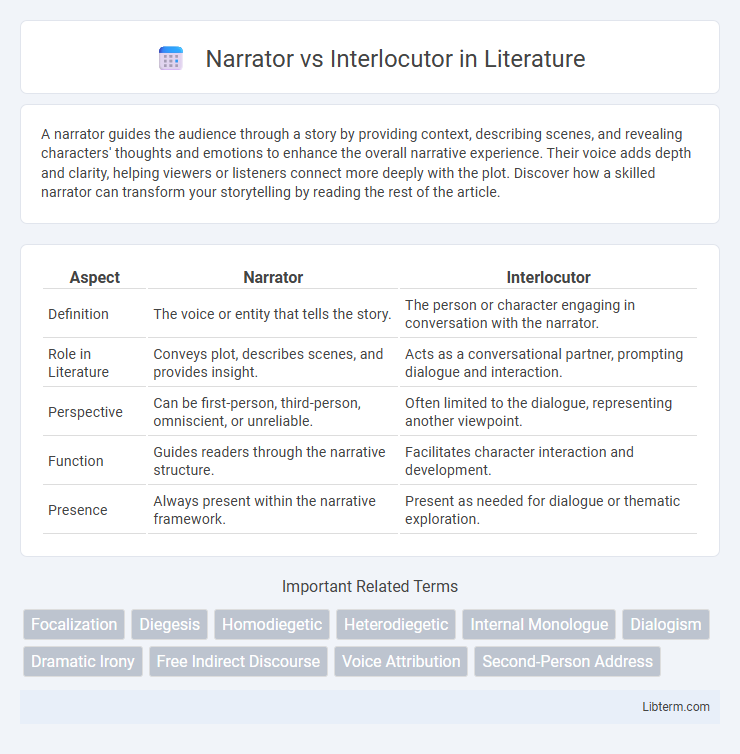A narrator guides the audience through a story by providing context, describing scenes, and revealing characters' thoughts and emotions to enhance the overall narrative experience. Their voice adds depth and clarity, helping viewers or listeners connect more deeply with the plot. Discover how a skilled narrator can transform your storytelling by reading the rest of the article.
Table of Comparison
| Aspect | Narrator | Interlocutor |
|---|---|---|
| Definition | The voice or entity that tells the story. | The person or character engaging in conversation with the narrator. |
| Role in Literature | Conveys plot, describes scenes, and provides insight. | Acts as a conversational partner, prompting dialogue and interaction. |
| Perspective | Can be first-person, third-person, omniscient, or unreliable. | Often limited to the dialogue, representing another viewpoint. |
| Function | Guides readers through the narrative structure. | Facilitates character interaction and development. |
| Presence | Always present within the narrative framework. | Present as needed for dialogue or thematic exploration. |
Introduction: Defining Narrator and Interlocutor
The narrator is the voice that tells the story, providing perspective and guiding the audience through the narrative, while the interlocutor engages directly in dialogue or conversation within the text. In literary and conversational analysis, the narrator controls the flow of information and shapes the narrative framework, whereas the interlocutor represents an interactive participant responding to or challenging the narrator's statements. Understanding the distinction between narrator and interlocutor is crucial for interpreting narrative structure and dialogue dynamics in literature and communication.
Core Differences Between Narrator and Interlocutor
The narrator serves as the voice that tells the story, guiding the audience through the plot, characters, and setting, often with a defined perspective and level of knowledge about the narrative. The interlocutor, by contrast, functions as a conversational partner within the dialogue, engaging directly with the narrator or other characters to advance the conversation or elicit information. Core differences lie in their roles: the narrator provides an overarching structure and commentary on the story, while the interlocutor participates interactively within the dialogue, shaping the communication and development of ideas.
Role of the Narrator in Storytelling
The narrator in storytelling serves as the primary voice guiding the audience through the plot, providing essential context, background information, and insight into characters' thoughts and emotions. Unlike the interlocutor, who engages directly in dialogue or conversation within the narrative, the narrator controls the flow of the story and shapes the listener's or reader's understanding. This role is crucial for establishing tone, pacing, and perspective, making the narrator a pivotal element in the construction and delivery of a compelling narrative.
Interlocutor: Function and Significance
The interlocutor serves as an essential participant in communication, facilitating dialogue by responding and posing questions that drive the conversation forward. This role enhances interaction by providing feedback, clarifying meaning, and maintaining the flow of discourse, ensuring mutual understanding between parties. In various contexts such as interviews, debates, and everyday conversations, the interlocutor's function contributes significantly to the effectiveness and coherence of verbal exchanges.
First-Person Narrator vs. Interlocutor Dynamics
The first-person narrator provides a subjective perspective, often revealing inner thoughts and emotions, while the interlocutor serves as a conversational counterpart shaping the narrative through dialogue. This dynamic creates a layered storytelling approach where the narrator's reliability and biases are continuously tested by the interlocutor's questions and responses. The interplay enhances character development and drives plot progression by highlighting contrasts and conflicts within the narrative voice.
Impact on Reader Engagement
The narrator shapes reader engagement by controlling the story's voice, tone, and depth of insight, creating intimacy or distance with the audience. The interlocutor, often a character within dialogue, drives immediate interaction and adds dynamism that can heighten emotional involvement. Together, they influence pacing and immersion, directly affecting how readers connect with the narrative.
Narrative Voice and Perspective: Key Contrasts
The narrator controls the narrative voice, shaping the story's perspective through first-person, third-person, or omniscient viewpoints that guide readers' understanding and emotional engagement. The interlocutor serves as a conversational partner within the text, offering direct dialogue or questions that reveal character traits and advance the plot without dominating the narrative voice. This distinction highlights how the narrator's perspective frames the overall story context, whereas the interlocutor's role focuses on interactive communication within that framework.
Examples from Literature
The narrator in literature provides the overarching voice guiding the story, such as the omniscient narrator in Jane Austen's *Pride and Prejudice* who offers insight into multiple characters' thoughts and settings. The interlocutor, by contrast, appears in dialogues or interviews within texts, exemplified by the conversational exchanges between Meursault and the chaplain in Albert Camus' *The Stranger*, where the interlocutor challenges the protagonist's beliefs. These roles distinctly shape narrative structure, with narrators framing context and interlocutors driving thematic exploration through direct interaction.
How Narrators and Interlocutors Shape Dialogue
Narrators guide the overall perspective and tone of a dialogue by controlling the flow of information and framing characters' speech, influencing how the audience interprets interactions. Interlocutors actively participate within the dialogue, shaping its direction and emotional intensity through their responses and engagement in conversation. The interplay between narrators and interlocutors creates dynamic, layered communication that enriches narrative complexity and enhances the storytelling experience.
Conclusion: Choosing Between Narrator and Interlocutor
Choosing between a narrator and an interlocutor depends on the desired narrative perspective and engagement level with the audience. Narrators provide a structured and often omniscient viewpoint, allowing for comprehensive storytelling and context delivery. Interlocutors create interactive dialogue, fostering immediacy and dynamic exchanges that enhance audience immersion.
Narrator Infographic

 libterm.com
libterm.com